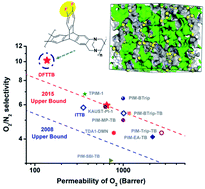Unprecedented gas separation performance of a difluoro-functionalized triptycene-based ladder PIM membrane at low temperature†
Abstract
Advanced membrane materials are playing increasingly important roles in solving global energy intensive separation problems. Herein, we introduce a high-performance intrinsically microporous Tröger's base-derived ladder polymer (DFTTB) as an advanced membrane material for low-temperature gas separation applications. DFTTB was obtained by design of a 2,3-difluoro-functionalized triptycene (DFTrip) building block. The resulting ladder polymer exhibited high microporosity (SBET = 918 m2 g−1), good thermal and mechanical properties, and excellent gas separation performance at or above the latest 2015 permeability/selectivity trade-off curves for H2/N2, H2/CH4 and O2/N2 with H2 and O2 permeabilities of 5468 and 650 barrer coupled with H2/N2, H2/CH4 and O2/N2 selectivities of 50, 38 and 6.0, respectively. Furthermore, DFTTB displayed unprecedented performance at sub-ambient temperatures with an O2/N2 selectivity of 10.1 and O2 permeability of 137 barrer at −30 °C. This high selectivity coupled with up to ∼100-fold higher O2 and H2 permeability than commercial glassy polymer membrane materials, provides new opportunities for low temperature air separation and hydrogen recovery from petrochemical process streams.



 Please wait while we load your content...
Please wait while we load your content...